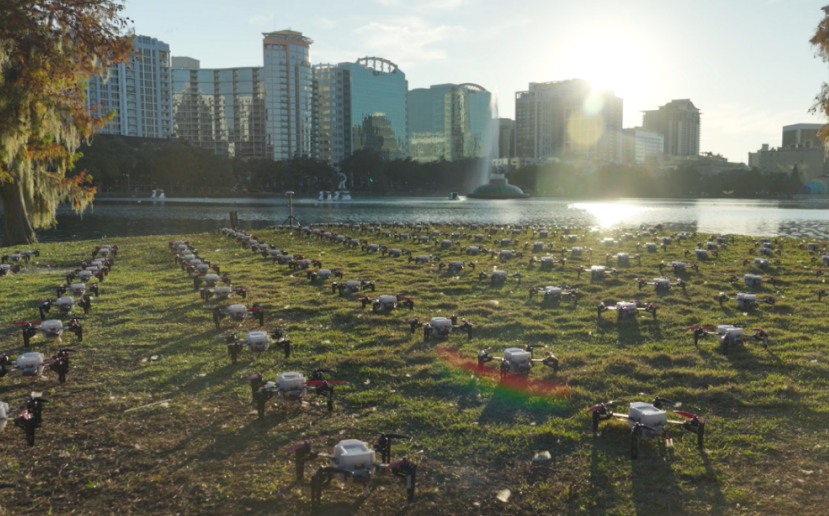The United States National Transportation Safety Board (NTSB) has released a preliminary report that details its findings from an investigation into the December 21, 2024 incident at Lake Eola in Orlando where several drones fell from a display, with some entering the crowd of spectators.
The swarm of around 500 Uvify IFO uncrewed aerial systems (UAS) were operated by Sky Elements LLC, doing business as Sky Elements Drone Shows. NTSB describes the Uvify IFO as “a small swarm light show drone, with four propellers weighing about 2.18 pounds. Overall dimensions are about 10.8 inches in length x 10.8 inches in width x 4.9 inches in height”.
The UAS light show was operating under the provisions of Title 14 Code of Federal Regulations Part 107 and a Certificate of Waiver and Authorization issued by the Federal Aviation Administration (FAA).
NTSB found that setup for the day was “standard and consisted of preflight checks, ensuring that the software programming matched and was updated on all show computers, and the layout of the 500-drone grid on the ground”.
The investigation found that about five aircraft were initially not accepting the launch data. Consequently, standard troubleshooting of the Wi-Fi access points was implemented, and all 500 aircraft were located on the network about five minutes before showtime. A soft reboot of the entire fleet was then conducted to bring all aircraft to “show ready” mode. After the reboot, all systems showed green except for the systems on two aircraft which were removed from the show. The operational aircraft were armed and the countdown sequence initiated.
“At liftoff it was noted that the aircraft ‘layers’ did not lift uniformly,” NTSB’s preliminary report states. “Further investigation revealed that the launch parameter file that contained the final flight paths had not been sent, and that the show centre was not completely aligned. Show video confirmed that the aircraft did not liftoff in uniform layers and as they illuminated and moved to their first frame of animation, they shifted position and altitude which resulted in a collision with other aircraft and a loss of control. After the collisions occurred numerous aircraft could be seen falling from the sky and impacting the ground. One aircraft could be seen streaking towards the audience.”
The remote pilot in command told NTSB investigators that, after the loss of control event, he closely monitored the remaining aircraft through visual observation and telemetry readings from the ground control station. “He determined that, due to the steps involved in pausing the show, recovering airborne aircraft and the designated flight paths, that the safest course of action for the audience and aircraft was to let the show proceed,” the report continues. “The remaining aircraft completed the show and landed without further incident. The operator reported that a review of aircraft logs revealed that the show position was rotated by 7°.” NTSB found that the 7° misalignment resulted in the geo hard fence being too close to the audience. In addition, investigators found that the fence was set to five metres rather than the company’s standard of one metre.
According to NTSB’s preliminary findings, the combined errors resulted in a reduced safety area that was outside of the company’s standards.
Each UAS contained a secure digital (SD) card that recorded data for that aircraft. Approximately 42 of the impacted UAS were recovered by the operator and their SD cards were sent to the NTSB’s Vehicle Recorder Laboratory in Washington, DC, for analysis. One aircraft was recovered by law enforcement personnel and sent to the NTSB. The report notes that five aircraft are believed to have impacted the lake and were not recovered.
In response to the Orlando incident, Sky Elements has proposed mitigations to the FAA to prevent future recurrence. These include allowing for additional time on site prior to showtime to reduce time pressures, establishing an on-call system that requires the chief pilot or a second in command to verify that all the necessary steps have been completed before showtime, and additional training for all remote pilots in command.
The investigation continues.
For more information
National Transportation Safety Board – United States
Image: Setup at Lake Eola. (Source: Sky Elements LLC via NTSB)




